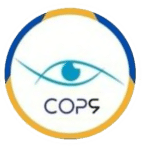The child’s, and the newborn’s, vision evolves fast: to perform an early screening in order to check whether or not there’s a vision disturbance is a necessity. Amblyopia is one of these. In this article, you will discover this pathology, also called “lazy eye”, its origins, symptoms, diagnosis, as well as the optical correction needed.

What does “Amblyopia” mean?
Amblyopia is also known as “the lazy eye”. This ocular disturbance is caused by a deficient binocular (both eyes) vision. It affects the visual field of the child. The brain will somehow reject the image in one eye. Said eye-ball is then put on hold. Unlike strabism, the eyes do not necessarily deviate from one another.
It’s a frequent cause of vision’s deterioration for children and it can lead to a permanent blindness or visual-impairment if said disturbance is not diagnosed at an early stage.
Around 2 to 3% of children under 2 are affected by amblyopia. However, this visual disturbance can occur at any age. Pediatric ophthalmological follow ups must then be performed on a regular basis, especially on very young children.
Our ophthalmologist, Dr. Stéphanie Zwillinger, specializes in pediatric ophthalmology. Do not hesitate to consult her, as well as the multidisciplinary COP9 team, for amblyopia!
Where does amblyopia come from?
As the Dr. Stéphanie Zwillinger explained in this video (in French), visual acuity of the newborn is not fully developed. Up until three, the baby’s brain and his or her visual system need clear information in order to fully develop optical and brain pathways. These connections will be fully grown around 8 or 9 years.
However, if the brain doesn’t receive enough information from an eye during this period, it will progressively conceal it, as if it doesn’t exist. It can lead to partial or complete visual loss.
This vision’s deterioration can be caused by:
- a refractive disorder which prevents correct focus (farsightedness, myopia, astigmatism);
- Sight obstruction, such as glaucoma or congenital cataract;
- an ocular axis disorder (strabismus).
Amblyopia can be genetic: parents, do not hesitate to screen your children as soon as possible for early care!
What are the symptoms of amblyopia?
Amblyopia is a pathology that mostly affects children. As such, it can be complex to detect symptoms on a day-to-day basis. Too young, they cannot articulate the vision problems they encounter. Too old, they do not have the notion their vision is impaired, since they grow up with this field of vision anomaly.
Parents, here our tips to recognize this visual deficiency. If your child:
- Squint his or her eyes;
- covers one eye;
- has an eye that goes to the inside or the outside;
- shows a blank pupil on pictures (complete cataract)
- has frequent headaches or visual fatigue;
- shows difficulty to perceive depth;
- seems clumsy or has coordination issues.
Should you identify one or more symptoms in the above list, we invite you to consult a pediatric ophthalmologist. He or she will then be able to redirect you and your child to an orthoptist and psychomotor rehabilitation. Our COP9 practice puts all of these cares at your disposal in a unique location.
How to diagnose amblyopia?
From birth, and during early childhood, an ophthalmological exam can be performed, in order to screen for vision disturbances. Please keep in mind that regular consultation is the best way to preserve your eyes health at any age.
During primary school, health practitioners perform a screening for vision disturbances within the institution. If they suspect amblyopia, the child will then be redirected toward an eye specialist, such as an ophthalmologist or an optometrist.
the diagnosis is carried out via painless ophthalmological tests. The eye exam is performed by the orthoptist, who then submits his or her orthoptics checkup to the pediatric ophthalmologist. The latter interprets the results and can perform complementary eye exams, such as a fundus. The ophthalmologist eventually suggests a coordinated care pathway as well as an adapted treatment.
What treatment against amblyopia?
If amblyopia is diagnosed early, it can be treated and corrected.
In the event of a refraction disorder, the child will wear corrective glasses or contact lenses. With a congenital cataract, a surgical intervention can be scheduled. An eye surgery can also be discussed with the parents in the case of a heavy strabism.
Should glasses be insufficient, the eye professional can prescribe you:
- an eye patch, put on the strong eye;
- eye-drops, instilled in the strong eye to blur the vision.
These solutions will strengthen the “lazy eye” by keeping it busy and stimulated. Wearing those daily will assure the child to recover a better visual acuity.
As a conclusion, eye health is essential from the youngest age! COP9 reminds you that you can detect amblyopia with a simple eye exam. Do not hesitate to consult an ophthalmologist to screen for disturbances at the first sign. Dr. Stéphanie Zwillinger can perform a personalized test regarding the age of your infant, and treat any visual disorder efficiently with her multidisciplinary team.
